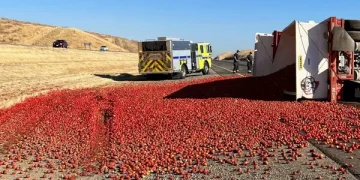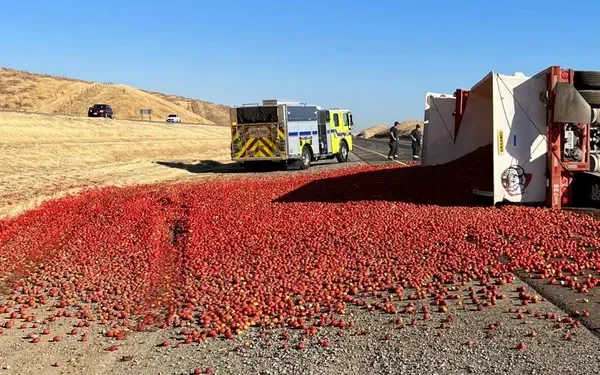How a Semi-Truck Overturning Near Patterson Affects the Tomato Market and Supply Chain
On the morning of October 5th, a significant incident occurred on Interstate 5 near Patterson, California, when a semi-truck transporting a load of tomatoes was involved in an accident. The crash, which took place just after 8 a.m. near the Sperry Avenue/Diablo Grande Parkway exit, led to the truck overturning and spilling its cargo across both northbound lanes. This event has not only disrupted traffic but also raised concerns about the potential impacts on the tomato supply chain in the region.
The Incident and Its Immediate Consequences
According to the California Department of Transportation (Caltrans), the accident caused both northbound lanes of I-5 to be closed, with the initial estimate for reopening set around 1 p.m. The semi-truck, which was carrying a significant quantity of tomatoes, ended up on its side, resulting in the spillage of the produce onto the roadway. The immediate aftermath saw a flurry of activity as emergency services and Caltrans crews worked to clear the wreckage and the spilled tomatoes from the road.
To mitigate the traffic disruption, Caltrans crews utilized the center divide as a temporary northbound lane, allowing for limited traffic flow while cleanup operations were underway. This measure helped alleviate some of the congestion caused by the lane closures but did not entirely resolve the traffic issues in the area.
Implications for the Tomato Supply Chain
The overturned tomato truck incident has several implications for the tomato supply chain and the broader agricultural market in California. The state is a major producer of tomatoes in the U.S., with a significant portion of its tomato crop transported via Interstate 5, a crucial transport route for agricultural products.
The direct impact of the accident on the tomato supply chain includes potential delays in the delivery of tomatoes to processing facilities and retailers. With the northbound lanes of I-5 closed for several hours, there are concerns about possible disruptions in the supply chain, which could affect both fresh market tomatoes and those destined for processing.
Potential Market Impacts
While the long-term effects of the incident on tomato prices and availability are still unfolding, several key issues may arise from this accident:
- Short-Term Supply Disruptions: The immediate spillage of tomatoes and the lane closure could cause short-term disruptions in the flow of tomatoes from farms to processing plants and retailers. This might lead to temporary shortages in the market, particularly if the truck’s load was substantial.
- Price Fluctuations: Disruptions in supply could potentially lead to fluctuations in tomato prices. If the spillage results in a significant loss of tomatoes, the supply shortage might drive up prices for both fresh tomatoes and processed tomato products.
- Logistics and Transportation Challenges: The accident highlights the vulnerability of transportation routes used for agricultural products. Delays on major highways can ripple through the supply chain, affecting the timely delivery of produce and potentially leading to logistical challenges for both farmers and distributors.
Long-Term Considerations
While the accident has caused immediate challenges, there are also broader lessons to consider for the future. The incident underscores the importance of maintaining and investing in robust transportation infrastructure for the agricultural sector. Ensuring that major transport routes are well-maintained and that contingency plans are in place for emergencies can help mitigate the impact of such accidents on the supply chain.
Additionally, the incident serves as a reminder of the need for ongoing safety measures and training for those involved in the transportation of agricultural products. Improved safety protocols and response strategies can help prevent similar accidents and minimize their impacts on the agricultural market.































